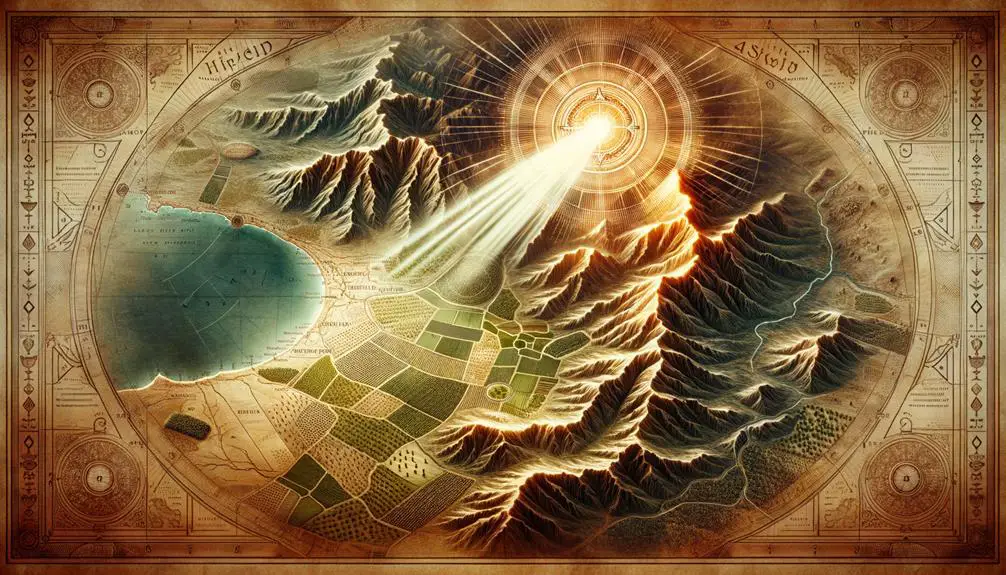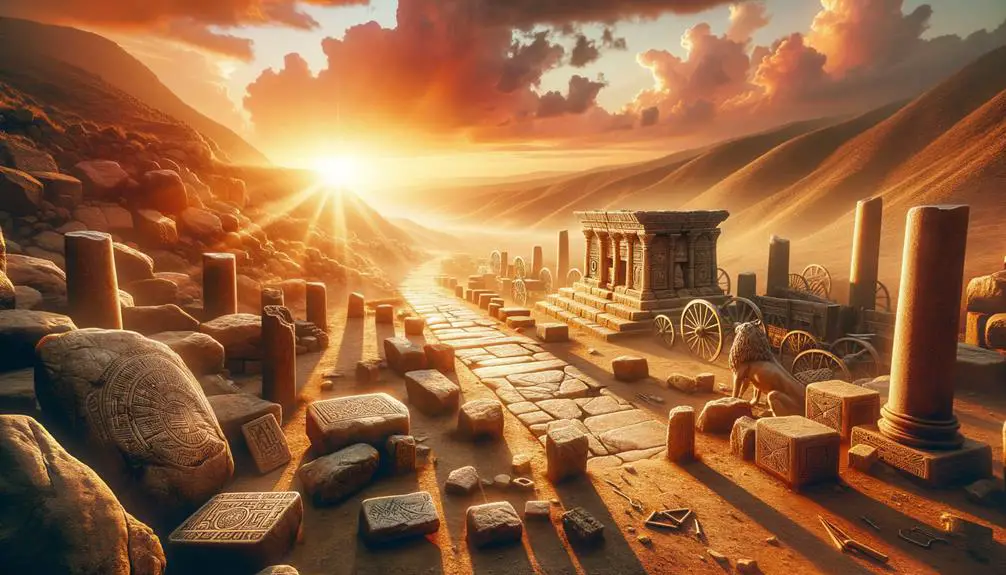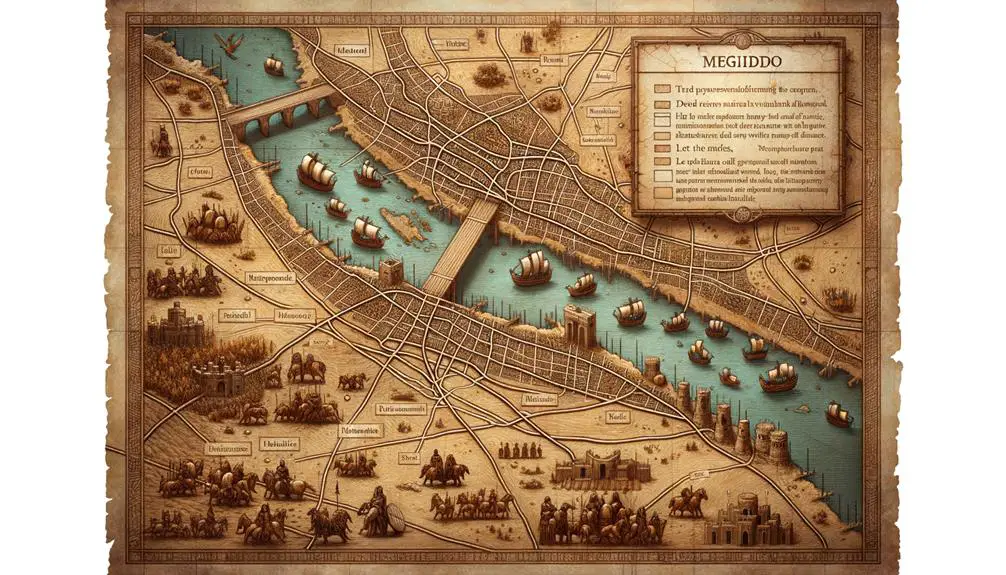Unlock the secrets of Megiddo in the Bible, a site of ancient battles and prophetic visions, to explore its enduring mystery and significance.

Where Is Megiddo in the Bible
Have you ever wondered if the ancient city of Megiddo, as mentioned in the Bible, truly holds the key to understanding the future prophecies and past battles that shaped the course of history?
Situated in the strategic Jezreel Valley, Megiddo's biblical significance spans from being a pivotal site of epic Old Testament battles to its prophetic mention in the Book of Revelation as Armageddon, the site of the ultimate battle between good and evil.
Its archaeological layers tell tales of civilization, conquest, and divine prophecy. To grasp the full magnitude of Megiddo's role in biblical and historical context, one must explore its layered past and the mysteries it still holds.
Key Takeaways
- Megiddo is depicted as a symbolic battleground of good versus evil in biblical narratives.
- It represents a site of divine judgments, embodying themes of justice and cosmic order.
- The location is historically and archaeologically significant, offering insights into biblical history.
- Megiddo's strategic position highlights its role in military, economic, and spiritual aspects of the biblical era.
Megiddo's Biblical Significance

Megiddo holds a pivotal role in biblical narratives, serving as the backdrop for numerous significant events and prophecies that have shaped Judeo-Christian eschatology. Its mention in the scriptures isn't merely geographical; it's imbued with deep layers of divine judgments and spiritual symbolism that merit a closer examination.
You'll find that Megiddo's significance extends beyond its physical ruins. It's a site where the metaphysical and the historical converge, offering insights into the divine plan and human destiny. The prophetic texts, especially those in Revelation, cast Megiddo, or Armageddon as it's symbolically known, as the ultimate battleground. This isn't just a place where armies clash; it's where good and evil are said to face off in a decisive showdown, highlighting the theme of divine judgment against rebellion.
The spiritual symbolism of Megiddo is rich and multifaceted. It stands as a testament to the inevitability of divine justice, a place where the righteous and the wicked receive their due according to the divine reckoning. This duality isn't only about reward and punishment; it's a reflection on the human condition, our choices, and the consequences thereof. Megiddo's biblical portrayal underscores the belief in a cosmic order that prevails despite human transgressions.
Therefore, when you delve into the biblical significance of Megiddo, you're not just exploring an ancient site. You're engaging with a profound narrative that weaves together themes of divine judgments and spiritual symbolism, offering a glimpse into the theological heart of Judeo-Christian eschatology.
Megiddo in Old Testament Battles
Throughout history, pivotal battles have unfolded at Megiddo, each echoing the site's profound biblical and strategic significance. This place, steeped in the lore of the Old Testament, showcases the evolution of military tactics and the crucial role of chariot warfare in ancient conflicts. The strategic position of Megiddo, controlling vital trade routes, made it a focal point for military confrontations that shaped the course of history.
Battle |
Significance |
|---|---|
Deborah's Victory |
Marked by innovative military tactics, this battle underlines the importance of leadership and the clever use of terrain. |
Gideon's Triumph |
Demonstrates the power of psychological warfare and strategic surprise in undermining enemy forces. |
Saul vs. Philistines |
Highlights the challenges of chariot warfare, especially in facing well-equipped adversaries on the plains of Megiddo. |
Josiah's Fall |
Shows the tragic consequences of miscalculation and the emergent dominance of archery and infantry over chariots. |
These battles not only exemplify the transformation of ancient warfare but also underscore Megiddo's critical role in military history. The progression from reliance on chariots to more complex military tactics, including psychological warfare and strategic positioning, reflects a broader evolution in how conflicts were conducted. Each confrontation at Megiddo wasn't just about the immediate combatants; it was a display of changing warfare paradigms, showcasing innovations that would influence battles far beyond the ancient Near East. The legacy of Megiddo, thus, lies not just in its biblical mentions but in its testament to the dynamic nature of military strategy and technology.
The Prophecy of Armageddon

In the annals of biblical prophecy, the term 'Armageddon' emerges as a symbol of apocalyptic warfare, foretelling a climactic battle between the forces of good and evil at the end of days. This concept, deeply rooted in Christian eschatology, finds its most vivid depiction in the Book of Revelation. The prophecy envisions a gathering of armies at a place called 'Armageddon,' a name derived from the Hebrew 'Har Megiddo,' which means 'Mount of Megiddo.'
You'll find that end time theories surrounding Armageddon are diverse and complex, ranging from literal interpretations predicting a physical battle in the geographical area of Megiddo, to more symbolic readings. The latter suggests that Armageddon represents the ongoing spiritual warfare between the divine and demonic forces within human history. Scholars in this camp argue that the prophetic imagery serves not to forecast specific events but to convey the certainty of God's ultimate victory over evil.
Symbolic interpretations often emphasize the metaphorical aspects of the prophecy. They suggest that the battle of Armageddon isn't confined to a single location or point in time but unfolds in the moral and spiritual choices of individuals across ages. This view aligns with broader theological perspectives that see biblical prophecies as multilayered, serving both immediate contexts and offering timeless truths about human nature and divine providence.
As you delve deeper into the prophecy of Armageddon, it's crucial to navigate these interpretations with a discerning mind. Understanding the symbolism and historical context behind these end time theories enriches your comprehension of biblical prophecies, revealing layers of meaning that transcend the literalist approach.
Megiddo's Archaeological Insights
Delving into the archaeological findings at the site, you'll uncover that the ancient city of Megiddo provides compelling evidence of its significant role in biblical history and prophecy. The meticulous application of excavation techniques has allowed archaeologists to piece together timelines, revealing layers of civilization that span thousands of years. Through careful stratigraphic analysis, scholars have identified settlement patterns, construction phases, and periods of destruction and renewal, which correlate with historical and scriptural accounts.
Artifact preservation at Megiddo has been paramount in understanding the daily lives, religious practices, and trade networks of its ancient inhabitants. The recovery of pottery, inscriptions, tools, and jewelry through precise excavation methods has provided invaluable insights. These artifacts, conserved with the latest preservation techniques, offer a tangible connection to the past, allowing for a detailed reconstruction of Megiddo's socio-economic and cultural landscapes.
Furthermore, the analysis of architectural remnants, such as the city's gates, walls, and palaces, underscores its architectural innovation and the strategic significance of its location. These structures, unearthed with advanced archaeological practices, reflect the ingenuity of ancient engineers and the city's role as a formidable fortress.
In synthesizing these archaeological insights, you'll appreciate how Megiddo's material culture and architectural achievements mirror its storied past. The site's excavation not only enriches our understanding of ancient Near Eastern civilizations but also illuminates the profound historical and prophetic importance ascribed to Megiddo in biblical texts. Through this archaeological lens, the layers of Megiddo's history are meticulously uncovered, revealing a narrative that spans millennia.
Megiddo's Strategic Importance

Megiddo's geographical position, perched at the crossroads of ancient trade routes, significantly amplified its strategic and military value in the biblical era. This unique placement not only made it a focal point for economic activity but also a coveted military stronghold. The convergence of vital trade routes at Megiddo facilitated the exchange of goods, ideas, and cultures from Asia, Africa, and Europe, bolstering its status as a thriving economic center. As trade flourished, Megiddo's wealth and importance grew, attracting the ambitions of various empires and armies.
As an agricultural hub, Megiddo's fertile surroundings contributed to its economic prosperity and its strategic military significance. The city's ability to sustain a sizable population and support large armies made it a key asset for any ruling power. Control over Megiddo meant access to crucial agricultural resources and a dominant position over trade routes, enabling rulers to exert influence over the region's economic flows. This agricultural abundance also ensured that the city could withstand sieges and maintain its defensive capabilities over extended periods.
The strategic importance of Megiddo in the biblical era is underscored by its repeated mention in historical and prophetic texts. Its position as a gateway between empires meant that control over Megiddo equated to control over the movement of goods, armies, and influence across the Near East. This reality made it a site of numerous conflicts and a symbol of military and economic power in the biblical narrative. Megiddo's story is a testament to the enduring impact of geography on historical destiny.
Frequently Asked Questions
How Has the Interpretation of Megiddo's Role in Biblical Prophecy Evolved Over Time Among Different Christian Denominations?
You've observed how interpretations of Megiddo's apocalyptic symbolism vary among Christian denominations.
Initially, you might see it as a literal battlefield in prophecy. However, over time, denominational perspectives have evolved.
Some view it metaphorically, emphasizing spiritual battles rather than physical ones. Others stick closely to a literal interpretation, anticipating an end-times conflict.
This shift reflects broader theological trends, where allegorical and historical-critical methods influence the understanding of biblical prophecy.
What Are the Environmental and Geographical Changes That Have Occurred in the Region Around Megiddo From Biblical Times to the Present Day?
You're delving into how regions transform over millennia.
Imagine a fertile valley, once teeming with diverse flora. Over time, agricultural practices intensified, altering the landscape.
Urban development crept in, further changing the terrain around Megiddo.
These shifts, from irrigation techniques to the rise of cities, paint a vivid picture of environmental evolution.
It's a testament to human impact, weaving a narrative of adaptation and change from biblical times to today.
How Has Megiddo Been Represented in Art, Literature, and Popular Culture Throughout History?
Megiddo's influence extends beyond historical and archaeological circles into popular culture. You've likely seen movies inspired by Megiddo, weaving its ancient tales into captivating narratives. Similarly, archaeological exhibitions have showcased Megiddo's artifacts, providing a tangible connection to its storied past.
These cultural representations, from literature to art, reflect Megiddo's enduring legacy, analyzing its impact from various angles. Through these mediums, Megiddo's historical and cultural significance is both preserved and celebrated.
Are There Any Significant Linguistic or Etymological Studies on the Name "Megiddo" That Shed Light on Its Meaning and Origins?
You're diving into the depths of ancient whispers, where Megiddo's name holds secrets.
Scholars have delved into its pronunciation, using archaeological methodologies to peel back layers of history.
These studies reveal a tapestry of cultures, wars, and civilizations, all encapsulated in a few syllables.
What Role Has Megiddo Played in Interfaith Dialogues and Interpretations Between Judaism, Christianity, and Islam?
You'll find Megiddo's role pivotal in fostering interfaith dialogues among Judaism, Christianity, and Islam. Archaeological discoveries at this site have sparked significant discussions at interfaith conferences, offering a shared historical platform.
These findings haven't only provided tangible evidence for religious narratives but also facilitated deeper understanding and respect among these faith traditions.
Conclusion
In your journey through the biblical landscape, think of Megiddo as a grand chessboard, with kings and prophets as its pieces, maneuvering through history's greatest gambits. Its soil, embedded with layers of conquest and prophecy, tells a story of strategic mastery and divine foresight.
Here, archaeology meets scripture, revealing a nexus of faith and fact. Megiddo's significance isn't just in its past battles but in its emblematic role in the ultimate showdown between good and evil, encapsulating the eternal struggle within the human spirit.



Sign up